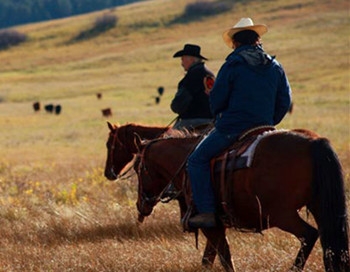
By the mid 1800s, the horse and the cowboy had come to symbolize the wild west. And of course, with the cowboys came cattle. As the bison quickly vanished from the landscape, cattle filled their place.
到19世紀中葉,馬與牛仔成為了遼闊西部的象征。當然,既然提到牛仔,那么一定會提到牛。隨著北美野牛快速地從大陸上消失,家牛取代了他們的位置。
Meanwhile increasing numbers of the tame horses escaped into the wild. These feral horses became known by the Spanish name, mustang. They put extra pressure on the dwindling bison numbers by competing for their grazing sites and drinking holes.
與此同時,越來越多的被馴服的馬兒逃到了西部。這些野馬成為了西班牙語中所稱的“木斯塘馬(mustang)”,它們數量的上升也給北美野牛的存活增添不少壓力,它們與北美野牛爭搶草原和水源。
Mustangs form social groups led by a dominant stallion, echoing their prehistoric relatives that lived here during the Ice Age.
木斯塘馬是一個群居的種族,由一匹占統治地位的公馬領導整個族群,這一點和它們冰河時代棲息于此的史前親戚相同。
Bred to carry the weight of a rider, mustangs are larger than those early wild horses, but they still display the same kind of behavior.
木斯塘馬是供人騎乘的,從體重看,他們比那些之前的野馬體型更大,但是兩種馬匹的行為有很多相同之處。
By the early 1800s, the wild horse was well and truly back in North America, but how did other wildlife on the continent survive alongside growing human populations?
19世紀早期,野馬真正回歸北美大陸,但是大陸上其他的野外生物是怎么在人類數量速度增加的情況下存活的呢?
Some wild creatures did the reverse of mustangs by becoming tame and choosing to live close to people. The purple martin became an unofficial mascot for native inhabitants in the eastern half of the continent. Here people erected special nesting sites to encourage the birds to stay.
一些野外生物也和木斯塘馬一樣選擇了追隨人類并被其馴服。在大陸的東半側,北美洲紫燕在當地居民眼中是一種吉祥物。在這里,人類為紫燕建巢并希望這些鳥兒留在這里。
英文文本來自普特英語,譯文屬可可原創,僅供學習交流使用,未經許可不得轉載。











